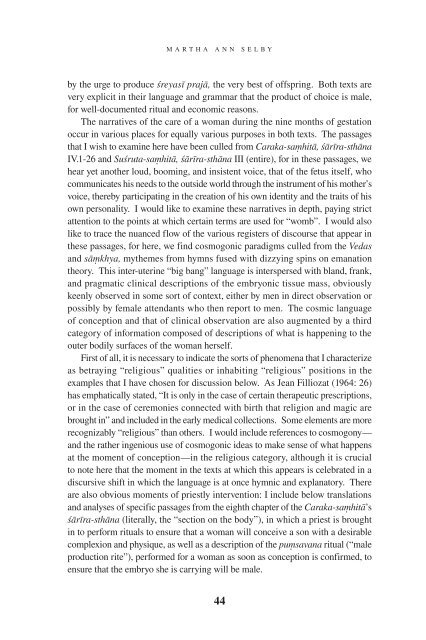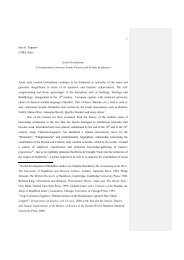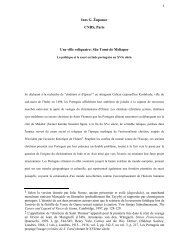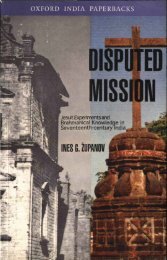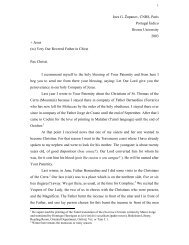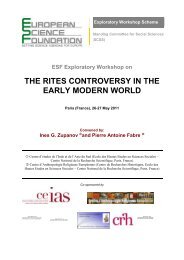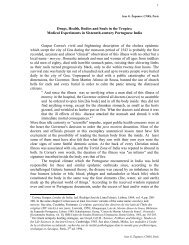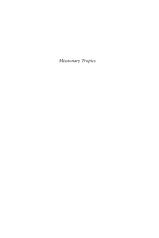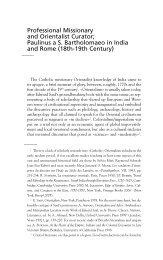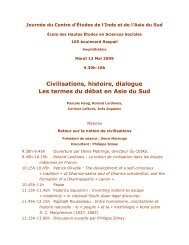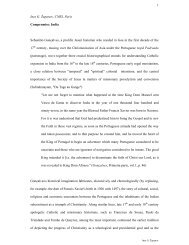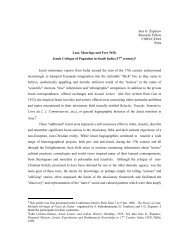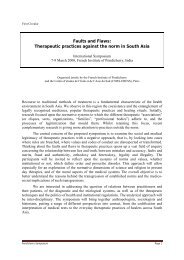- Page 1 and 2: 00•Depart.indd 1 23/12/08 12:30:1
- Page 3 and 4: DIVINS REMÈDES EN ASIE DU SUD DIVI
- Page 5 and 6: DIVINS REMÈDES MÉDECINE ET RELIGI
- Page 7 and 8: SOMMAIRE caterina guenzi et ines g.
- Page 9 and 10: D I V I N E R E M E D I E S I N S O
- Page 11 and 12: c a t e r i n a g u e n z i e t i n
- Page 13 and 14: i n t r o d u c t i o n XX e siècl
- Page 15 and 16: i n t r o d u c t i o n L’engouem
- Page 17 and 18: i n t r o d u c t i o n Pour l’an
- Page 19 and 20: i n t r o d u c t i o n tique, ouvr
- Page 21 and 22: i n t r o d u c t i o n exacte comm
- Page 23 and 24: i n t r o d u c t i o n La question
- Page 25 and 26: i n t r o d u c t i o n gence entre
- Page 27 and 28: i n t r o d u c t i o n plusieurs a
- Page 29 and 30: i n t r o d u c t i o n partagent u
- Page 31 and 32: i n t r o d u c t i o n le lieu par
- Page 33 and 34: i n t r o d u c t i o n NOTES 1. Vo
- Page 35 and 36: i n t r o d u c t i o n Greenough,
- Page 37 and 38: i n t r o d u c t i o n Prakash, G.
- Page 39 and 40: Le religieux dans le médical 02•
- Page 41 and 42: m a r t h a a n n s e l b y BETWEEN
- Page 43: s h i f t s i n Ā y u r v e d i c
- Page 47 and 48: s h i f t s i n Ā y u r v e d i c
- Page 49 and 50: s h i f t s i n Ā y u r v e d i c
- Page 51 and 52: s h i f t s i n Ā y u r v e d i c
- Page 53 and 54: s h i f t s i n Ā y u r v e d i c
- Page 55 and 56: s h i f t s i n Ā y u r v e d i c
- Page 57 and 58: s h i f t s i n Ā y u r v e d i c
- Page 59 and 60: s h i f t s i n Ā y u r v e d i c
- Page 61 and 62: s h i f t s i n Ā y u r v e d i c
- Page 63 and 64: s h i f t s i n Ā y u r v e d i c
- Page 65 and 66: s h i f t s i n Ā y u r v e d i c
- Page 67 and 68: L a u r e n t P o r d i é Télesco
- Page 69 and 70: T é l e s c o p a g e s r e l i g
- Page 71 and 72: T é l e s c o p a g e s r e l i g
- Page 73 and 74: T é l e s c o p a g e s r e l i g
- Page 75 and 76: T é l e s c o p a g e s r e l i g
- Page 77 and 78: T é l e s c o p a g e s r e l i g
- Page 79 and 80: T é l e s c o p a g e s r e l i g
- Page 81 and 82: T é l e s c o p a g e s r e l i g
- Page 83 and 84: T é l e s c o p a g e s r e l i g
- Page 85 and 86: T é l e s c o p a g e s r e l i g
- Page 87 and 88: T é l e s c o p a g e s r e l i g
- Page 89 and 90: T é l e s c o p a g e s r e l i g
- Page 91 and 92: T é l e s c o p a g e s r e l i g
- Page 93 and 94: T é l e s c o p a g e s r e l i g
- Page 95 and 96:
T é l e s c o p a g e s r e l i g
- Page 97 and 98:
T é l e s c o p a g e s r e l i g
- Page 99 and 100:
m a r i n e c a r r i n Le service
- Page 101 and 102:
s a v o i r e t b i o g r a p h i e
- Page 103 and 104:
s a v o i r e t b i o g r a p h i e
- Page 105 and 106:
s a v o i r e t b i o g r a p h i e
- Page 107 and 108:
s a v o i r e t b i o g r a p h i e
- Page 109 and 110:
s a v o i r e t b i o g r a p h i e
- Page 111 and 112:
s a v o i r e t b i o g r a p h i e
- Page 113 and 114:
s a v o i r e t b i o g r a p h i e
- Page 115 and 116:
s a v o i r e t b i o g r a p h i e
- Page 117 and 118:
s a v o i r e t b i o g r a p h i e
- Page 119 and 120:
s a v o i r e t b i o g r a p h i e
- Page 121 and 122:
s a v o i r e t b i o g r a p h i e
- Page 123 and 124:
s a v o i r e t b i o g r a p h i e
- Page 125 and 126:
s a v o i r e t b i o g r a p h i e
- Page 127 and 128:
s a v o i r e t b i o g r a p h i e
- Page 129 and 130:
s a v o i r e t b i o g r a p h i e
- Page 131 and 132:
s a v o i r e t b i o g r a p h i e
- Page 133 and 134:
Traditions savantes et pratiques lo
- Page 135 and 136:
d a v i d g o r d o n w h i t e Amu
- Page 137 and 138:
a m u l e t t e s e t l a m b e a u
- Page 139 and 140:
a m u l e t t e s e t l a m b e a u
- Page 141 and 142:
a m u l e t t e s e t l a m b e a u
- Page 143 and 144:
a m u l e t t e s e t l a m b e a u
- Page 145 and 146:
a m u l e t t e s e t l a m b e a u
- Page 147 and 148:
a m u l e t t e s e t l a m b e a u
- Page 149 and 150:
a m u l e t t e s e t l a m b e a u
- Page 151 and 152:
a m u l e t t e s e t l a m b e a u
- Page 153 and 154:
a m u l e t t e s e t l a m b e a u
- Page 155 and 156:
a m u l e t t e s e t l a m b e a u
- Page 157 and 158:
a m u l e t t e s e t l a m b e a u
- Page 159 and 160:
a m u l e t t e s e t l a m b e a u
- Page 161 and 162:
a m u l e t t e s e t l a m b e a u
- Page 163 and 164:
f a b r i z i o s p e z i a l e Le
- Page 165 and 166:
l e m é d e c i n d e s r ê v e s
- Page 167 and 168:
l e m é d e c i n d e s r ê v e s
- Page 169 and 170:
l e m é d e c i n d e s r ê v e s
- Page 171 and 172:
l e m é d e c i n d e s r ê v e s
- Page 173 and 174:
l e m é d e c i n d e s r ê v e s
- Page 175 and 176:
l e m é d e c i n d e s r ê v e s
- Page 177 and 178:
l e m é d e c i n d e s r ê v e s
- Page 179 and 180:
l e m é d e c i n d e s r ê v e s
- Page 181 and 182:
l e m é d e c i n d e s r ê v e s
- Page 183 and 184:
l e m é d e c i n d e s r ê v e s
- Page 185 and 186:
l e m é d e c i n d e s r ê v e s
- Page 187 and 188:
l e m é d e c i n d e s r ê v e s
- Page 189 and 190:
l e m é d e c i n d e s r ê v e s
- Page 191 and 192:
c a t e r i n a g u e n z i planèt
- Page 193 and 194:
p l a n è t e s , r e m è d e s e
- Page 195 and 196:
p l a n è t e s , r e m è d e s e
- Page 197 and 198:
p l a n è t e s , r e m è d e s e
- Page 199 and 200:
p l a n è t e s , r e m è d e s e
- Page 201 and 202:
p l a n è t e s , r e m è d e s e
- Page 203 and 204:
p l a n è t e s , r e m è d e s e
- Page 205 and 206:
p l a n è t e s , r e m è d e s e
- Page 207 and 208:
p l a n è t e s , r e m è d e s e
- Page 209 and 210:
p l a n è t e s , r e m è d e s e
- Page 211 and 212:
p l a n è t e s , r e m è d e s e
- Page 213 and 214:
p l a n è t e s , r e m è d e s e
- Page 215 and 216:
p l a n è t e s , r e m è d e s e
- Page 217 and 218:
p l a n è t e s , r e m è d e s e
- Page 219 and 220:
Rituels de rémission 08•ClarkDec
- Page 221 and 222:
i s a b e l l e c l a r k - d e c
- Page 223 and 224:
a t a m i l r i t u a l o f v i s u
- Page 225 and 226:
a t a m i l r i t u a l o f v i s u
- Page 227 and 228:
a t a m i l r i t u a l o f v i s u
- Page 229 and 230:
a t a m i l r i t u a l o f v i s u
- Page 231 and 232:
a t a m i l r i t u a l o f v i s u
- Page 233 and 234:
a t a m i l r i t u a l o f v i s u
- Page 235 and 236:
a t a m i l r i t u a l o f v i s u
- Page 237 and 238:
a t a m i l r i t u a l o f v i s u
- Page 239 and 240:
W i l l i a m s a x “I have no on
- Page 241 and 242:
i t u a l h e a l i n g a n d f a m
- Page 243 and 244:
i t u a l h e a l i n g a n d f a m
- Page 245 and 246:
i t u a l h e a l i n g a n d f a m
- Page 247 and 248:
i t u a l h e a l i n g a n d f a m
- Page 249 and 250:
i t u a l h e a l i n g a n d f a m
- Page 251 and 252:
i t u a l h e a l i n g a n d f a m
- Page 253 and 254:
i t u a l h e a l i n g a n d f a m
- Page 255 and 256:
i t u a l h e a l i n g a n d f a m
- Page 257 and 258:
i t u a l h e a l i n g a n d f a m
- Page 259 and 260:
i t u a l h e a l i n g a n d f a m
- Page 261 and 262:
Stratégies de guérison 10•Zupan
- Page 263 and 264:
i n e s G . Ž u p a n o v Conversi
- Page 265 and 266:
c o n v e r s i o n , i l l n e s s
- Page 267 and 268:
c o n v e r s i o n , i l l n e s s
- Page 269 and 270:
c o n v e r s i o n , i l l n e s s
- Page 271 and 272:
c o n v e r s i o n , i l l n e s s
- Page 273 and 274:
c o n v e r s i o n , i l l n e s s
- Page 275 and 276:
c o n v e r s i o n , i l l n e s s
- Page 277 and 278:
c o n v e r s i o n , i l l n e s s
- Page 279 and 280:
c o n v e r s i o n , i l l n e s s
- Page 281 and 282:
c o n v e r s i o n , i l l n e s s
- Page 283 and 284:
c o n v e r s i o n , i l l n e s s
- Page 285 and 286:
c o n v e r s i o n , i l l n e s s
- Page 287 and 288:
c o n v e r s i o n , i l l n e s s
- Page 289 and 290:
c o n v e r s i o n , i l l n e s s
- Page 291 and 292:
c o n v e r s i o n , i l l n e s s
- Page 293 and 294:
c o n v e r s i o n , i l l n e s s
- Page 295 and 296:
c o n v e r s i o n , i l l n e s s
- Page 297 and 298:
c o n v e r s i o n , i l l n e s s
- Page 299 and 300:
c o n v e r s i o n , i l l n e s s
- Page 301 and 302:
i g i t t e s é b a s t i a Apaise
- Page 303 and 304:
a p a i s e r l a s o u f f r a n c
- Page 305 and 306:
a p a i s e r l a s o u f f r a n c
- Page 307 and 308:
a p a i s e r l a s o u f f r a n c
- Page 309 and 310:
a p a i s e r l a s o u f f r a n c
- Page 311 and 312:
a p a i s e r l a s o u f f r a n c
- Page 313 and 314:
a p a i s e r l a s o u f f r a n c
- Page 315 and 316:
Incommoder les esprits : posture qu
- Page 317 and 318:
Un patient diagnostiqué « schizop
- Page 319 and 320:
a p a i s e r l a s o u f f r a n c
- Page 321 and 322:
a p a i s e r l a s o u f f r a n c
- Page 323 and 324:
a p a i s e r l a s o u f f r a n c
- Page 325 and 326:
a p a i s e r l a s o u f f r a n c
- Page 327 and 328:
a p a i s e r l a s o u f f r a n c
- Page 329 and 330:
a p a i s e r l a s o u f f r a n c
- Page 331 and 332:
m a t t h i a s f r e n z Salus Inf
- Page 333 and 334:
“ c u l t u r e o f h e a l i n g
- Page 335 and 336:
“ c u l t u r e o f h e a l i n g
- Page 337 and 338:
“ c u l t u r e o f h e a l i n g
- Page 339 and 340:
“ c u l t u r e o f h e a l i n g
- Page 341 and 342:
“ c u l t u r e o f h e a l i n g
- Page 343 and 344:
“ c u l t u r e o f h e a l i n g
- Page 345 and 346:
“ c u l t u r e o f h e a l i n g
- Page 347 and 348:
“ c u l t u r e o f h e a l i n g
- Page 349 and 350:
“ c u l t u r e o f h e a l i n g
- Page 351 and 352:
“ c u l t u r e o f h e a l i n g
- Page 353 and 354:
“ c u l t u r e o f h e a l i n g


